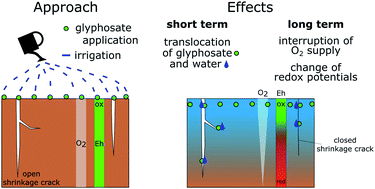Heavy rainfall following a summer drought stimulates soil redox dynamics and facilitates rapid and deep translocation of glyphosate in floodplain soils†
Abstract
We present field data on the effects of heavy rainfall after drought on the mobility of glyphosate and redox conditions in a clayey floodplain soil. By applying glyphosate together with deuterated water as conservative tracer in combination with time resolved in situ redox potential measurements, the spatial and temporal patterns of water infiltration and pesticide transport as well as the concomitant changes of the redox conditions were revealed. Our findings demonstrate that shrinkage cracks in dry soils can serve as effective transport paths for atmospheric oxygen, water and glyphosate. The rain intensity of a typical summer storm event (approx. 25 mm within one hour) was sufficient to translocate deuterated water and glyphosate to the subsoil (50 cm) within 2 hours. Soil wetting induced partial closure of the shrinkage cracks and stimulated microbial activity resulting in pronounced dynamics of in situ soil redox conditions. Redox potentials in 40 to 50 cm depth dropped permanently to strongly reducing conditions within hours to days but fluctuated between reducing and oxidizing conditions in 10 to 30 cm depth. Our findings highlight the close link between the presence of macropores (shrinkage cracks), heavy rainfall after drought, redox dynamics and pesticide translocation to the subsoil and thus call for further studies addressing the effects of dynamic redox conditions as a limiting factor for glyphosate degradation.

- This article is part of the themed collection: Contaminant remediation and fate


 Please wait while we load your content...
Please wait while we load your content...